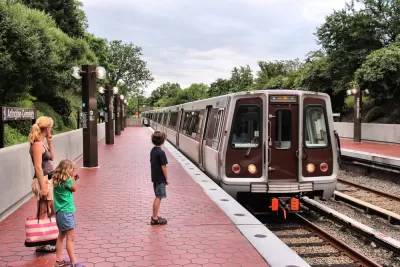The historically car-dependent county is hoping the planned revitalization of the Blue Line Corridor will boost the local economy and help maintain affordable housing.

In what Ethan Goffman calls "a radical break for a county with a history of developing in 'a spread out and automobile dependent' fashion," Maryland's Prince George’s County "has signed on to the transit-oriented development (TOD) revolution to boost its economy while helping the environment." According to the plan, "The Blue Line Corridor will become a major economic engine for the County by catalyzing development, creating jobs, and incentivizing the development of a sports and entertainment-branded corridor."
"The Blue Line would be the template for a much-needed economic boost for Prince George’s County that simultaneously helps the environment and maintains affordable housing." The plan "emphasizes business and economic development, crucial in a county with plenty of housing but relatively few jobs." Its authors hope it will attract large, institutional employers and raise the average annual salary in the area to a level closer to the rest of the D.C. region. "The plan’s second broad goal is to increase commercial tax collection by $100 million annually, enhancing much-needed local services. Third is increasing the population by 50,000 in areas near transit, including a mix of incomes and housing types."
"The plan’s fourth goal is preserving affordable housing and a diverse housing stock even in the midst of growth." The county also hopes to "increase food retail options in low-income areas to make fresh, healthy food widely accessible" and enhance "identifiable character" through public features and amenities.
"The plan is proactive on [the issue of displacement], calling for building 26,000 new residential units, 75% of which would be dedicated as affordable to households making less than 120% of the area median income," which could help fill the need for so-called 'missing middle' housing.
FULL STORY: Prince George’s County outlines plans for ambitious transit-oriented development along the Blue Line

Planetizen Federal Action Tracker
A weekly monitor of how Trump’s orders and actions are impacting planners and planning in America.

San Francisco's School District Spent $105M To Build Affordable Housing for Teachers — And That's Just the Beginning
SFUSD joins a growing list of school districts using their land holdings to address housing affordability challenges faced by their own employees.

The Tiny, Adorable $7,000 Car Turning Japan Onto EVs
The single seat Mibot charges from a regular plug as quickly as an iPad, and is about half the price of an average EV.

Seattle's Plan for Adopting Driverless Cars
Equity, safety, accessibility and affordability are front of mind as the city prepares for robotaxis and other autonomous vehicles.

As Trump Phases Out FEMA, Is It Time to Flee the Floodplains?
With less federal funding available for disaster relief efforts, the need to relocate at-risk communities is more urgent than ever.

With Protected Lanes, 460% More People Commute by Bike
For those needing more ammo, more data proving what we already knew is here.
Urban Design for Planners 1: Software Tools
This six-course series explores essential urban design concepts using open source software and equips planners with the tools they need to participate fully in the urban design process.
Planning for Universal Design
Learn the tools for implementing Universal Design in planning regulations.
Smith Gee Studio
City of Charlotte
City of Camden Redevelopment Agency
City of Astoria
Transportation Research & Education Center (TREC) at Portland State University
US High Speed Rail Association
City of Camden Redevelopment Agency
Municipality of Princeton (NJ)


























